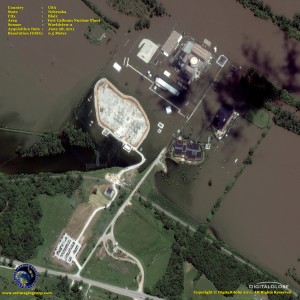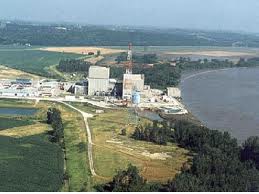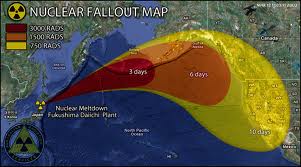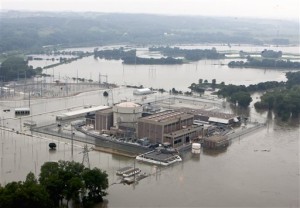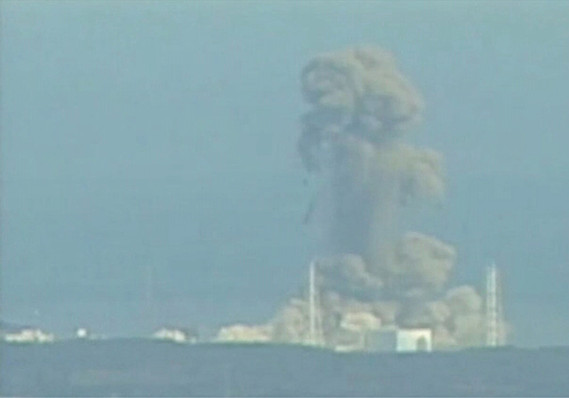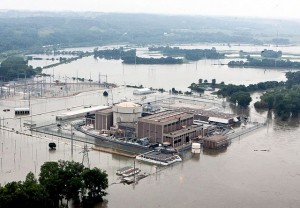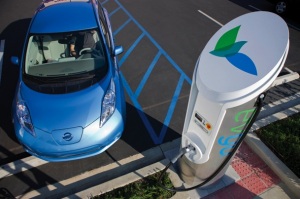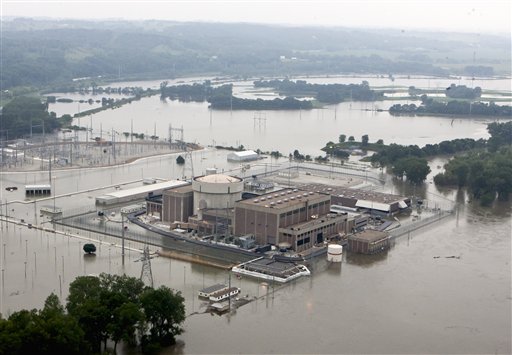The Fort Calhoun nuclear plant reopened in December, 2013. The plant, on the west bank of the Missouri River about 20 miles north of Omaha, Nebraska, closed for refueling in April, 2011, and was flooded in June, 2011. Refueling a nuclear plant typically takes about 6 – 12 weeks. Due to the flooding, the Fort Calhoun plant was closed for 970 days, from April, 2011 until December, 2013. (NY Times / Associated Press, here). Back in June, 2011, the cost estimate by David Lochbaum, Union of Concerned Scientists, was roughly $970 Million in lost revenue, plus the costs of repairs. Continue reading
Category Archives: Fort Calhoun
Fort Calhoun Nuclear Power Station: Offline Since April, 2011, Two Years Four Months, and Counting
Two Years Ago, April, 2011, the Fort Calhoun nuclear power station, on the banks of the Missouri River, north of Omaha, Nebraska, was shut down for refueling. It should have been a routine operation. According to the Nuclear Energy Institute, NEI.Org, here, “U.S. nuclear reactors shut down once every 18 to 24 months to refuel approximately one-third of the reactor. In the 1980s and early ’90s the average refueling outage lasted about three months. Over the past decade, refueling outage durations have improved substantially. Now a typical refueling outage lasts one month.” Clearly Fort Calhoun, shut down for refueling 28 months ago in April, 2011, is not typical. Continue reading
Nuclear Power – Not “Carbon Free” Energy
Jeff Hanson, spokesman for the Omaha Public Power District, OPPD, in discussing the Fort Calhoun reactor, closed since April, 2011 for refueling then, in June, 2011, due to flooding, said,
“[Nuclear power is] a reliable source of electricity that’s carbon-free. That becomes more valuable going forward,” OPPD spokesman Jeff Hanson said.
This assertion that nuclear power is “carbon free” or that it produces “no greenhouse gases” is based on a simplified view of one aspect of the nuclear power – fissioning uranium – and ignores the complete picture.
While fissioning uranium does not release carbon dioxide, when we look at the entire fuel / waste cycle we see that getting uranium out of the ground, fashioning it into fuel rods, transporting the fuel rods to the plant and managing the waste requires energy, and much of this energy releases carbon dioxide.
Fort Calhoun Nuclear Plant, Update.
Back in April, 2011, the Fort Calhoun nuclear power plant, on the banks of the Missouri River about 19 miles north of Omaha, was shut down for refueling. The timing was perfect because in June, 2011, the Missouri River flooded. As pictured above, the plant that had been on the shore of the river was suddenly in the middle of the river.
THE PLANT IS STILL SHUT-DOWN – 20 Months after the incident.
Erin Golden, of the Omaha World News, told me on Dec. 19, 2012,
The plant is expected to be $129 million over budget in 2012. The OPPD [Omaha Public Power District] has set a target for the First Quarter of 2013 to bring the plant back on line. And the people at OPPD are optimistic that they will get the plant back on-line. The NRC, however, is not optimistic.
Nuclear Power, One Year After Fukushima
 In the 54 years between 1957, when the Price Anderson Act was passed, and 2011 we have:
In the 54 years between 1957, when the Price Anderson Act was passed, and 2011 we have:
- Experienced four melt-downs and one partial melt-down at nuclear power plants,
- An increasing amount of radioactive waste that we really don’t know how to deal with, but must manage for hundreds of years – or thousands.
- Security Concerns. Sharif Mobley, an American, arrested in Yemen in March, 2010, suspected of being a covert agent of Al Queda connected to Anwar Al Awlaki (CS Monitor), and who, before going to Yemen, worked at nuclear power plants in New Jersey, Pennsylvania, and Maryland (NJ News Room).
The World Nuclear Association has a detailed summary of the state of the industry (here), at Popular Logistics, We have concluded that a thorough understanding of the dynamics of the system and the risks from existing or future nuclear plants demands a paradigm shift to efficient use of sustainable energy.
The people of Fukushima – and Japan – are concerned that their food is “salted” with radioactive isotopes from the three reactors that melted downs. And they don’t trust their government. They feel it is too trusting of the people in the nuclear power industry (NPR). And we see the same cozy relationship between the regulatory agencies and the regulated industry in the United States. (PopularLogistics).
The “No More Fukushimas” walk from Oyster Creek to Vermont Yankee continues – and it will pass Indian Point today, March 11, 2012 (here).
The Japanese have closed 52 of their 54 nuclear power plants.
In the US, eight plants, from North Carolina to Connecticut were closed in August, 2011 because of Hurricane Irene. Two plants in Virginia were closed because of an earthquake. Fort Calhoun, the plant that was built on the bank of the Missouri River, near Omaha, Nebraska, that was shut down in May, 2011 for refueling and kept off-line due to heavy rains in June 2011 and 9 months later remains shut down. While the distribution of radioactive isotopes is minimal, and mostly tritium, the financial cost (not counting waste cleanup) is $1.0 million per day. These costs will be carried on the shoulders of the ratepayers, not the owners of the plant (here).
When Excelon whined that “upgrading Oyster Creek would cost too much; they would have to close it down,” Gov. Chris Christie said “Ok, then close it down.” The folks in Georgia are not as bold as the Honorable Governor of New Jersey. When Georgia Power said “In order to build two new 1.17 GW reactors at the Vogtle complex, we need to charge ratepayers for construction before we break ground, the NRC said “OK, and here are loan guarantees” (here).
But Georgia is the exception to the rule. Mycle Schneider, describing the Worldwatch Report he wrote on nuclear power last year, said (Press Release / Report):
“The industry was arguably on life support before Fukushima. When the history of this industry is written, Fukushima is likely to introduce its final chapter.”
Amory Lovins, of the Rocky Mountain Institute, in the foreword to the report, wrote,
“The Fukushima accident has just vaporized the balance sheet of the world’s #4 power company, TEPCO… this … could cost $100-plus billion… with such an unforgiving technology, accidents anywhere are accidents everywhere.”
Popular Logistics is a blog. We have the resources to write one or two articles per week, and cover a variety of issues. The professional news media, i.e., The New York Times, National Public Radio are able to commit substantial resources to these issues.
Nuclear Crisis in Japan will lead you to a collection of articles about Japan, Fukushima and the future of nuclear power from the Federation of American Scientists (FAS)
Matthew L. Wald (preceding link to Mr. Wald’s posts on the Green Blog, Transcripts Show U.S. Confusion Early in Japan Nuclear Crisis ; (on NYTimes.com)
Andrew C. Revkin, Nuclear Risk and Fear, from Hiroshima to Fukushima from the Dot Earth Blog, also of The Times,
Mr. Wald, again, Sizing Up Health Impacts a Year After Fukushima.
We now are experiencing the effects of four melt-downs and one partial melt-down in the 54 years since the Price Anderson Act was signed. This is four melt-downs too many. This is one meltdown every 13.5 years, one melt-down or partial melt-down every 11 years. While this is too small for statistical analysis, there have been melt-downs at four of the world’s 440 nuclear power plants. That’s a small number – about 0.9%. But the accidents were and remain catastrophic.
And in addition, nuclear power is expensive in terms of time and money for new plants (NPR). It’s too expensive for investors given the choice; that’s why Georgia Power asked for – and got – loan guarantees and permission to charge ratepayers in advance for the money to build the Vogtle 3 and 4 plants (here).
As noted above:
We must understand the dynamics of the system and risks from existing or future nuclear plants and shift the paradigm to efficient use of sustainable energy.
No More Fukushimas: From Coal, Oil, and Nuclear to Sustainable Energy
On March 11, 2011, the Fukushima nuclear disaster shocked the world. Sadly, the thinkers in the anti-nuclear world were not complete surprised. We were startled, but we know that disasters, while unpredictable, are inevitable. Disasters are built into the nuclear power system. The best engineers are fallible. (Anyone who drives a car or uses a personal computer knows this.) We can engineer nuclear reactors to be “reasonably” safe – but that costs a lot of money. That’s why ALL nuclear reactors leak “acceptable” levels of tritium – it is too expensive to capture all the tritium.
We also know
- While the probability of an accident may be low, the probability is very high that an accident, if it occurs, will be
- In Three Mile Island, in 1979, Chernobyl, in 1968, and Fukushima, in 2011, we have four melt-downs and one partial melt-down since the Price Anderson Act was first signed into law in 1956. That’s four melt-downs in 56 years. While it’s a too small to give a precise statistical measure, it offers empirical data to suggest a high probability of a catastrophic accident every 14 years.
In command economies, such as existed in the Soviet Union, or exists in Iran and North Korea, it is illegal – and dangerous – to question the government. In market economies, such as exist in the United States, Europe, and Japan, there are strong incentives to cut corners.
But back to Fukushima – following the disaster, nearly all of Japan’s 54 Nuclear Plants have been shut down due to pressure by the Japanese people.
The disaster deposited radioactive fallout on a semicircular area of Japan with a radius of 50 miles. It caused the permanent displacement of 160,000 people. An unknown amount of radioactive materials have been flushed into the Pacific Ocean. TEPCO, the owners of the reactors, have a $100 Billion liability (that will probably be absorbed by Japanese citizens over the next 20 or 50 years).
So after Fukushima, the question that we ought to be asking is not: “Can solar, wind, geothermal, marine current and other sustainable technologies meet our energy needs?”
The question is: “HOW can solar, wind, geothermal, marine current and other sustainable technologies meet our energy needs?”
I will be speaking on Monday, March 5th, at 6:00pm, at the Unitarian Universalist Meeting House on West Front Street in Lincroft, NJ. This will be part of a series of discussions along a 250 mile walk from Oyster Creek, in Ocean County, NJ to Vermont, Yankee, in Vernon, Vermont. I will make a statement similar to the talk at the Space Coast Green Living Festival, reported here.
A group of Japanese Buddhists, Fukushima eye-witnesses and US citizens will be walking over 250 miles from Oyster Creek to Indian Point to the Vermont Yankee Nuclear Power Plants to bring awareness of the terrible risks of nuclear power. The “No More Fukushimas Peace Walk” is being led by Jun Yasuda.
Scheduled events open to the public:
Friday March 2nd, 7pm, “Implications of the Fukushima Nuclear Disaster for the U.S and continuing Japanese crisis”
Little Theatre, Georgian Court University, 900 Lakewood Ave, Lakewood N.J.
Speakers:
- Sachiko Komagata, P.T., Ph.D, and Associate Professor & Chair, Department of Holistic Health & Exercise Science
- Rachel Dawn Fudim-Davis, New Jersey Organizer, Food & Water Watch
- Jeff Tittel, Director of Sierra Club, NJ Chapter
- Sister Mary-Paula Cancienne, RSM, PhD.
Hosts: Sister Mary Bilderback, Mary Paula Cancienne
For information Kasturi DasGupta, PhD 732-987-2336
Saturday, March 3, 6:00 pm,
Sky Walk Cafeteria, 2nd Floor, 129 Hooper Ave, Toms River, NJ (Connected to parking garage)
Speakers:
- Sky Sims, Sustainable energy specialist;
- Joseph Mangano, Executive Director of Radiation and Public Health Project;
- Ed M. Koziarski and Junko Kajino, Filmakers
For information Burt Gbur, 732-240-5107
Sunday, March 4th, 6:00 pm,
Murray Grove Retreat Conference Center, Lanoka-Harbor, NJ Church Lane and US Highway 9
Speakers:
- Willie DeCamp, Save Barnegat Bay,
- Greg Auriemma, Esq., Chair, Ocean County Sierra Club,
- Peter Weeks.
For information Matt Reid, 609-312-6798
Monday, March 5th, 6:00pm,
Unitarian Universalist Meeting House, West Front Street, Lincroft, NJ
Speakers:
- Larry Furman, “Beyond Fuel: The Transition from Fossil Fuel and Nuclear Power to Sustainable Energy.”
- Japanese walkers share their post-Fukushima experiences in Japan
For Information:. Elaine Held (732-774-3492).
Thursday, March 8, 6:00 pm
Puffin Foundation, 20 Puffin Way, Teaneck, N.J.
Speaker:
- Sidney Goodman, Author ‘Asleep At the Geiger Counter: Nuclear Destruction of the Planet and How to Stop It’, ISBN: 978-1-57733-107-0, available from Blue Dolphin Publishing, and elsewhere.
For information Jules Orkin, 201-566-8403
The walk will start at 10am on Saturday, March 3rd near the Oyster Creek area, and end at 129 Hooper Ave, Toms River. Starting times and places for March 4th and 5thwill also be announced on February 27th.
————————————————–
The mission of the Walk:
A plea for the people of New Jersey, New York and New England to recognize the grave dangers that nuclear energy poses to our lives, property, and all life on the planet.
We walk together in love and solidarity for a nuclear free future, and a more just, sustainable, and compassionate world built on respect for all living beings.
JOIN THE WALK FOR AN HOUR OR A DAY.
Edith Gbur 732-240-5107
Christian Collins 413-320- 2856
Cathy Sims 732-280-2244
21 of 2011 – Most Significant Events of the Year
Tweet ![]() While it ain’t over till it’s over, 2011 is over. A lot that could have happened, didn’t. Obama didn’t resign, Donald Trump didn’t throw his hat into the ring or divorce his current wife and marry one or more Kardashians. Newt Gingrich threw his hat into the ring, but also didn’t divorce his current wife and marry one or more Kardashians. These are the most significant events of 2011.
While it ain’t over till it’s over, 2011 is over. A lot that could have happened, didn’t. Obama didn’t resign, Donald Trump didn’t throw his hat into the ring or divorce his current wife and marry one or more Kardashians. Newt Gingrich threw his hat into the ring, but also didn’t divorce his current wife and marry one or more Kardashians. These are the most significant events of 2011.
- Japan, March, 2011 . Nebraska, June, 2011. An earthquake triggered a tsunami which slammed Japan with a 30 foot wave, which shut down twelve nuclear reactors at three sites, triggering melt-downs in three reactors at the Fukushima Dai-ichi site. We now see radioactive particles in food and soil in Fukushima Prefecture. The United States government recommended an evacuation of a 50 mile radius from the plant – this is a semi-circular no-man’s land of 3,927 square miles. It would be 7,854 square miles but the plant was on the coast and therefore half of this radioactive no-man’s land is in the Pacific Ocean. The environmental ramifications of radioactive materials spreading over Japan and flowing into the Pacific Ocean are not known (Popular Logistics click here, here, here), however, liabilities to TEPCO and Japan are estimated to $100 Billion (click here). In the United States, two nuclear power plants on the Missouri River, the Fort Calhoun and Cooper plants, were shut-down when the Missouri River flooded (Popular Logistics, here).
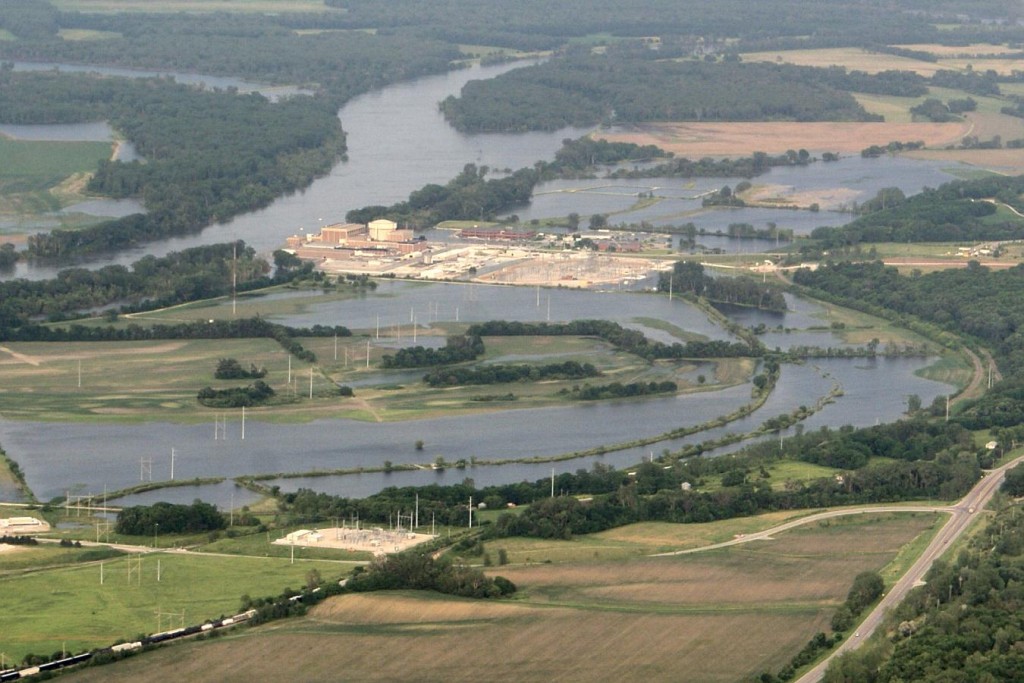 Eight nuclear power plants from South Carolina to Connecticut were shut down in the aftermath of the earthquake that struck with an epicenter in Virginia August 23, 2011, and Hurricane Irene a few days later (Popular Logistics, here). In the words of Mycle Schneider, describing the World Watch Institute report he authored, “The industry was arguably on life support before Fukushima. When the history of this industry is written, Fukushima is likely to introduce its final chapter,” (click here). However, the three melt-downs at Fukushima, coupled with the melt-down at Chernobyl in 1986 and the partial melt-down at Three Mile Island in 1979, suggest a probability of one melt-down every 14 years.
Eight nuclear power plants from South Carolina to Connecticut were shut down in the aftermath of the earthquake that struck with an epicenter in Virginia August 23, 2011, and Hurricane Irene a few days later (Popular Logistics, here). In the words of Mycle Schneider, describing the World Watch Institute report he authored, “The industry was arguably on life support before Fukushima. When the history of this industry is written, Fukushima is likely to introduce its final chapter,” (click here). However, the three melt-downs at Fukushima, coupled with the melt-down at Chernobyl in 1986 and the partial melt-down at Three Mile Island in 1979, suggest a probability of one melt-down every 14 years. - South Carolina, North Carolina, Virginia, Maryland, Delaware, New Jersey, Pennsylvania, New York, Connecticut, Massachusetts, and Vermont, August, 2011. Hurricane Irene covered an area of approximately 170,000 square miles, or about the size of California.”
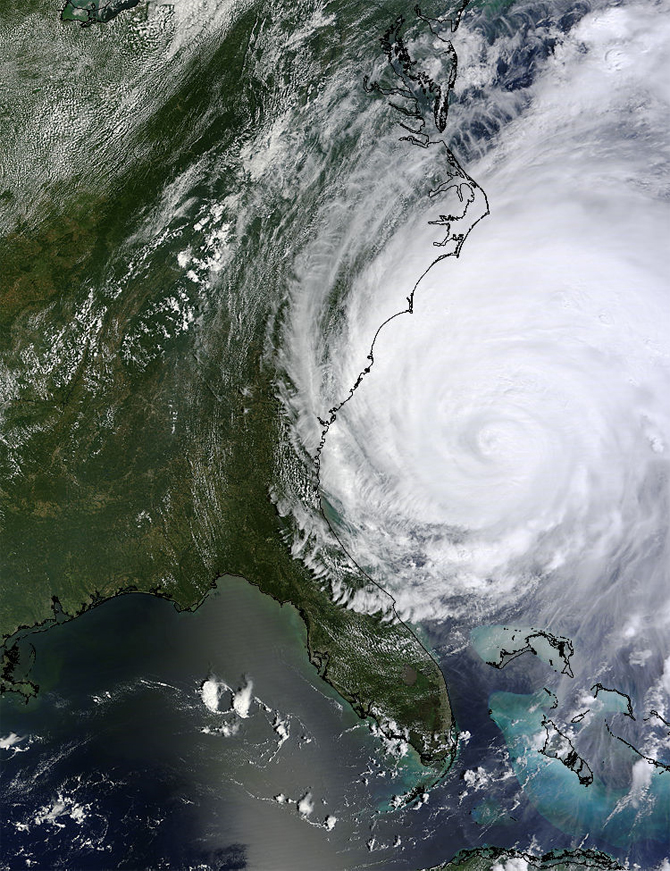
- Washington, DC, December. 2011. After 4,000 Americans were killed, about 50,000 were wounded, and $1 trillion was spent over 8 years, President Obama ended the American mission in Iraq that Congress authorized in October, 2002, President Bush started in March, 2003 and declared “Accomplished” in May, 2003 (for a timeline, click here).
- Washington DC, Abbottabod, Pakistan, May, 2011, American soldiers, on orders from the White House, found and killed Osama bin Laden in a compound in Pakistan (NY Times, click here).
- Yemen, In summer, 2011, American military forces, using a drone aircraft piloted from the ground via remote control, from the ground, targeted and killed Anwar al Awlaki, an American born Al Queda operative in Yemen (NY Times, click here).
- The hacking group “Anonymous” broke into the computers of the security consulting group “Stratfor” and found 44,188 Encrypted Passwords, of which roughly 50% could be easily cracked. 73.7% of decrypted passwords were weak” (NPR, click here).
- The “Stuxnet” computer worm virus, harmelss on PC’s runing MS Windows, Mac OS X, and Linux, and other computers, appears to have targeted centrifuges used in the Iranian uranium enrichment facilities. While the viruses were discovered in 2010, they became understood in 2011. The virus caused the centrifuges to spin out of control, wrecking themselves (NY Times, here, NPR here, CNET here, Wikipedia here). Continue reading
"Beyond Fuel" at the Space Coast Green Living Festival
![]() Tweet I am presenting “Beyond Fuel: From Consuming Natural Resources to Harnessing Natural Processes,” a discussion of the hidden costs, or “economic externalities,” of nuclear power, coal, and oil, and the non-obvious benefits of wind, solar, marine hydro and efficiency at the Space Coast Green Living Festival, Cocoa Beach, Florida, Sept 17, 2011.
Tweet I am presenting “Beyond Fuel: From Consuming Natural Resources to Harnessing Natural Processes,” a discussion of the hidden costs, or “economic externalities,” of nuclear power, coal, and oil, and the non-obvious benefits of wind, solar, marine hydro and efficiency at the Space Coast Green Living Festival, Cocoa Beach, Florida, Sept 17, 2011.
The festival is sponsored by the Cocoa Beach Surfrider Foundation and the Sierra Club Turtle Coast Group. It will be at the Cocoa Beach Courtyard by Marriott.
Clean Energy, Good Jobs, and a Vibrant Economy … But
![]() Tweet It sounds too good to be true:
Tweet It sounds too good to be true:
* 100 gigawatts of offshore wind, $300 Billion,
* 100 gw of landbased wind, $200 Billion,
* 75 gw of solar, $300 Billion,
* 75 gw of geothermal, $200 Billion.
* 200 gigawatt equivalents of efficiency – $200 Billion.
* 100 & Clean, Renewable, Sustaianble Energy: 1.2 Trillion.
* 2.7 Million New Jobs and a Healthy Economy: Priceless!
This is happening, slowly, inexorably, by the “invisible hand of the market.” But it will happen faster if the “invisible mind of the community” acts. This means the government!
Fort Calhoun Nuclear Plant – Update
![]() Tweet The flooded Fort Calhoun nuclear power plant is not exactly like the nuclear plants at Fukushima Daichi and Fukushima Diana. There are three main differences: First of all, there’s one plant, not 12. The difference of scale is tremendous. Secondly, it was offline – shut down for refueling – when flooded. Meaning, we got lucky, really lucky. Finally, it was hit by the gradually increasing pressures of rising floodwaters, not by an earthquake, a tsunami, and aftershocks. This is huge!
Tweet The flooded Fort Calhoun nuclear power plant is not exactly like the nuclear plants at Fukushima Daichi and Fukushima Diana. There are three main differences: First of all, there’s one plant, not 12. The difference of scale is tremendous. Secondly, it was offline – shut down for refueling – when flooded. Meaning, we got lucky, really lucky. Finally, it was hit by the gradually increasing pressures of rising floodwaters, not by an earthquake, a tsunami, and aftershocks. This is huge!
Steve Everly, at the Kansas City Star, reported that David Lochbaum of the Union of Concerned Scientists was “Reassured.” (here). I spoke to Mr. Lochbaum about the flooded plant on June, 29, 2011.
Most of the releases of radioactive material, generally tritium and tritiated water, occur when plants are online. Because the plant was offline, very little radioactive material has been released into the biosphere as a result of the flooding. While it is easy to filter heavy metals, it is very expensive to isolate tritiated water from water.
The damages due to the flooding are likely to be in the ballpark of $1,000,000 per day in lost revenue – $23 Million since June 6 – because the plant produces power worth about $1,000,000 per day. The buildings that have been damaged are collateral buildings, not the reactor itself. Those buildings would be less expensive to repair than the reactor.
At 35 years old, the plant is near the end of its design life. While we can engineer plants that are as safe as the NRC requires, new wind, solar, geothermal, hydro, and efficiency cost less than new nuclear or coal with carbon sequestration. Safety, security, and waste management are not the challenges with sustainable technologies that they present with nuclear and coal. Therefore, it seems logical to consider that once it is decommissioned, the plant will be replaced with wind, solar, geothermal, hydro, and efficiency.
Brookings, SAP, NRG, and the City of New York on our Energy Future
![]() Tweet Will moving to the new energy future – deploying Solar, Wind and other sustainable alternatives create 2.7 Million New Jobs?
Tweet Will moving to the new energy future – deploying Solar, Wind and other sustainable alternatives create 2.7 Million New Jobs?
At “How Cities and Companies Can Work Together to Operate in the New Energy-Constrained Economy” a panel discussion (press release), Bruce Katz, Vice President and Director of the Metropolitan Policy Program, Brookings Institution, said “2.7 million new jobs” will be created in moving to the clean energy / low carbon economy.
Mr. Katz also noted that two out of three Americans – 200 million people – live in the 100 biggest metropolitan areas, and those 200 million people are responsible for 75% of our GDP. High carbon energy is no longer cheap. The people in those metropolitan areas, and elsewhere, therefore, must act. Continue reading
Flooding at Nebraska Nuclear Power Plants
![]() Tweet Omaha, Nebraska. Flooding on the Missouri River at The Cooper and Fort Calhoun nuclear power stations. I suppose the good news is that given the flooding, one or both of these two Nebraska plants will be decommissioned after the floodwates recede, so there will soon be one or two fewer nuclear plants operating in the United States. And terrorists will have a difficult time attacking these plants now that they are surrounded by a moat. The real good news, if you can call it that, is that these floods are the result of heavy rains, not a tsunami triggered by an earthquake. The pressures are different. It is a steady buildup and which will be followed by steady decrease. It is not the surge / vacuum of a tsunami. And there was no earthquake and series of aftershocks.
Tweet Omaha, Nebraska. Flooding on the Missouri River at The Cooper and Fort Calhoun nuclear power stations. I suppose the good news is that given the flooding, one or both of these two Nebraska plants will be decommissioned after the floodwates recede, so there will soon be one or two fewer nuclear plants operating in the United States. And terrorists will have a difficult time attacking these plants now that they are surrounded by a moat. The real good news, if you can call it that, is that these floods are the result of heavy rains, not a tsunami triggered by an earthquake. The pressures are different. It is a steady buildup and which will be followed by steady decrease. It is not the surge / vacuum of a tsunami. And there was no earthquake and series of aftershocks.
